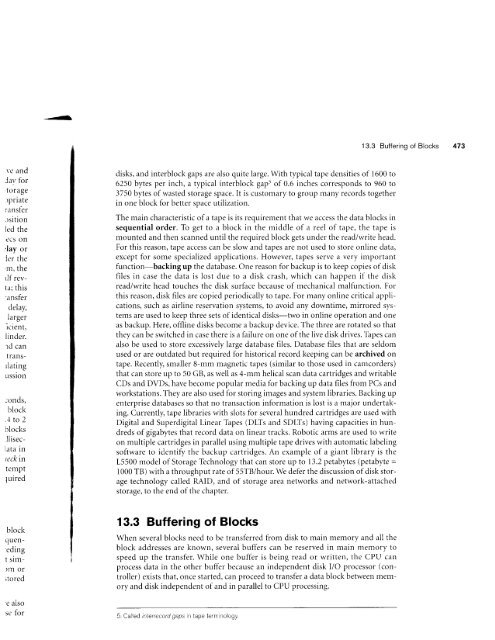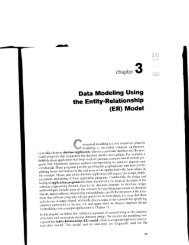13.1 through 13.5, 13.10 and 13.11
13.1 through 13.5, 13.10 and 13.11
13.1 through 13.5, 13.10 and 13.11
Create successful ePaper yourself
Turn your PDF publications into a flip-book with our unique Google optimized e-Paper software.
13.3 Buffering of Blocks473r-e' <strong>and</strong>lav fbr.torage.rpriateransfer.lsitionled theecs onrlay orler the,m, therlf revta;this'ansferclelay,largerlcient,linder..rd cantransrlatingussion--onds,block.1 to2blockslliseclatainrcck intemptquireddisks, <strong>and</strong> interblock gaps are also quite large. With typical tape densities of 1600 to6250 bytes per inch, a typical interblock gap5 of 0.6 inches corresponds to 960 to3750 bytes of wasted storage space. It is customary to group rnany records togetherin one block for better space utilization.The main characteristic of a tape is its requirement that we access the data blocks insequential order. To get to a block in the middle of n reel of terpe, the tape ismounted <strong>and</strong> then scanned until the required block gets under the read/write head.For this reason, tape access can be slow <strong>and</strong> tapes are not used to store online data,except for some specialized applications. However, tapes serve a very importantfunction-backing up the database. One reason for backup is to keep copies of diskfiles in case the data is lost due to a disk crash, which can happen if the diskread/write head touches the disk surface because of mechanical malfunction. Forthis reason, disk flles are copied periodicaily to tape. For mar-ry online critical applications,such as airline reservation systems, to avoid any downtime, mirrored systemsare used to keep three sets of identical disks-two in online operation <strong>and</strong> oneas backup. Here, offline disks become a backup device. The three are rotated so thatthey can be switched in case there is a failure on one of the iive disk drives. T[pes canalso be used to store excessively large database files. Database files that are seldomused or are outdated but required for historical record keeping can be archived ontape. Recently, smaller 8-mm magnetic tapes (sirnilar to those used in camcorders)that can store up to 50 GB, as well as 4-mm helical scan data cartridges <strong>and</strong> writableCDs <strong>and</strong> DVDs, have become popular n-redia for backing up data files from PCs <strong>and</strong>workstations. They are also used for storing irnages <strong>and</strong> system libraries. Backing upenterprise databaseso that no transaction information is lost is a major undertaking.Currently, tape libraries with slots for several hundred cartridges are used withDigital <strong>and</strong> Superdigital Linear Tapes (DLfs <strong>and</strong> SDLTs) having capacities in hundredsof gigabytes that record data on linear tracks. Robotic arms are used to writeon multiple cartridges in parallel using rnultiple tape drives with automatic labelingsoftware to identify the backup cartridges. An example of a giant library is theL5500 model of Storage Technology that can store up to 13.2 petabytes (petabyte =1000 TB) with a <strong>through</strong>put rate of 55TB/hour. We defer the discussion of disk storagetechnology called RAID, <strong>and</strong> of storage area networks <strong>and</strong> network-attachedstorage, to the er-rd of the chapter.blockquenedingI Slm-)rTt or;tored'e alsose for13.3 Buffering of BlocksWhen several blocks need to be transferred from disk to main memory <strong>and</strong> all theblock addresses are known, several buffers can be reserved in main memory tospeed up the transfer. While one bufTer is being read or written, the CPU canprocess data in the other buffer because an ir-rdependent disk I/O processor (controller)exists that, once started, can proceed to transfer a data block between rnemory<strong>and</strong> disk independent of <strong>and</strong> in parallel to CPU processing.5, Called interrecord gaps n tape term nology














